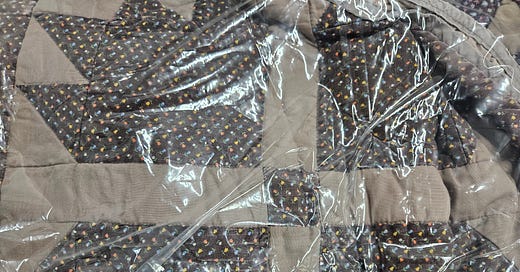My grandmother made a quilt for me, the only son of her oldest son, before she died. Here it is, still wrapped in a protective plastic bag I’ve kept it in for the last couple of decades:
This quilt was probably stitched together 30 or 40 years ago, and I’ve somehow managed to preserve it reasonably well.
See those geometric designs? That pattern is called a bear claw design, and it became popular in the US during the 1930s, when my grandmother was just becoming a young lady. I suspect she and her two sisters grew up very, very quickly during this time.
The colors of the pattern made sense during an era when sacks to carry food were repurposed for fabric. Everything was repurposed during the Great Depression. This was a great way for people not only to be intensely frugal—a matter of survival—but also to express themselves creatively.
Truly, this has to be where I got the intense frugality that got me through my twenties. When I look at this quilt my grandmother made for me, I am reminded of all this history, and it comes rushing to my mind in an instant when I glance at it.
When it was given to me, though? That’s another story. I already had a blanket, after all, so I couldn’t understand why this was such an incredible gift.
I get it now.
Quilts seemed unremarkable to a kid like me, and they are indeed straightforward in concept. The idea is to carefully sew one ornate side that everyone sees, then create a very plain (but functional) side underneath. Finally, you stuff the apparatus with something that insulates you.
You know what insulates really, really well in nature? Feathers. If you watch a show that takes place before the modern era, and the people are living in luxury, you’re very likely to see a feather-stuffed pillow.
Feathers stuff things, and they also insulate things extremely well. It made sense to me, then, that the word quilt must have come from the word quill.
In my mind’s eye, I could see how that letter t at the end came to be, where they just threw it on to indicate that it was something stuffed with quills. It was, therefore, a bit of a surprise to find out that the two words are actually completely different in origin.
Quilt actually arises from the Latin word culcita. Wealthy ancient Romans slept on these stuffed sacks that could be used as a mattress or cushion. This original meaning really didn’t change all that much over the centuries, filtering through old French as cuilte before being morphed one more time into English.
Although the Romans gave quilts their name, the idea of a quilt is far more ancient, and widespread across the ancient world. Anywhere there was sewing, there were (eventually) quilts.
Quill, on the other hand, comes from a Germanic root. Germanic and Latin were the two great language families playing tug-of-war over much of Europe during the middle ages, and it’s no surprise to me that these are the two languages that make up most of modern English.
The Middle Low German word quiele, gave us the word we use today. The precise root isn’t known—there was a great deal of Latin written down during the ancient world as compared to Germanic script, and so we know the original words in Latin much more of the time.
Quill also came to mean a couple of other things over time. One of them is the iconic writing instrument you might envision someone like Isaac Newton using to write his Principia Mathematica, or the signers of the Declaration of Independence using to seal the deal and give that middle finger to the British Empire, once and for all.
Porcupines also have quills, so-named for the resemblance to feathers. That etymology is easier to explain.
Do you have a quilt yourself, or did you use one when you were younger? Are there any other particular family heirlooms that have a history, something you’ve learned about your own past over the years?







I have a blue jean quilt my mom made. The other thing about why they used small pieces is because they saved all their fabric scraps and quilting was one way to make something new from them even if they were small reminents.
I am well familiar with quilts after playing Patchwork (the two-player board game) with my wife.
I find that if you wrap a quill in a quilt and then you s-quint your eyes just so, you can quickly quit having friends or even ac-quaintances.